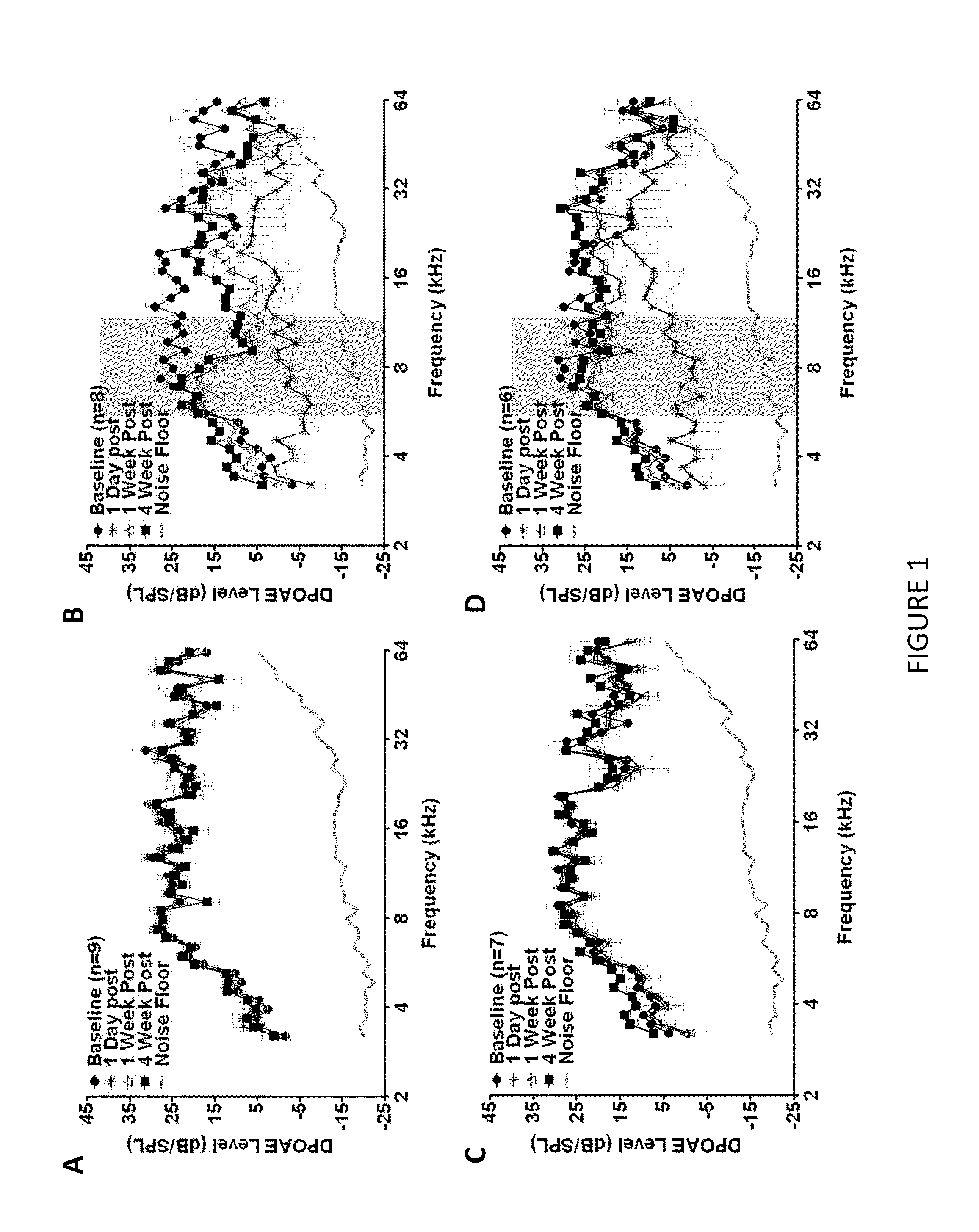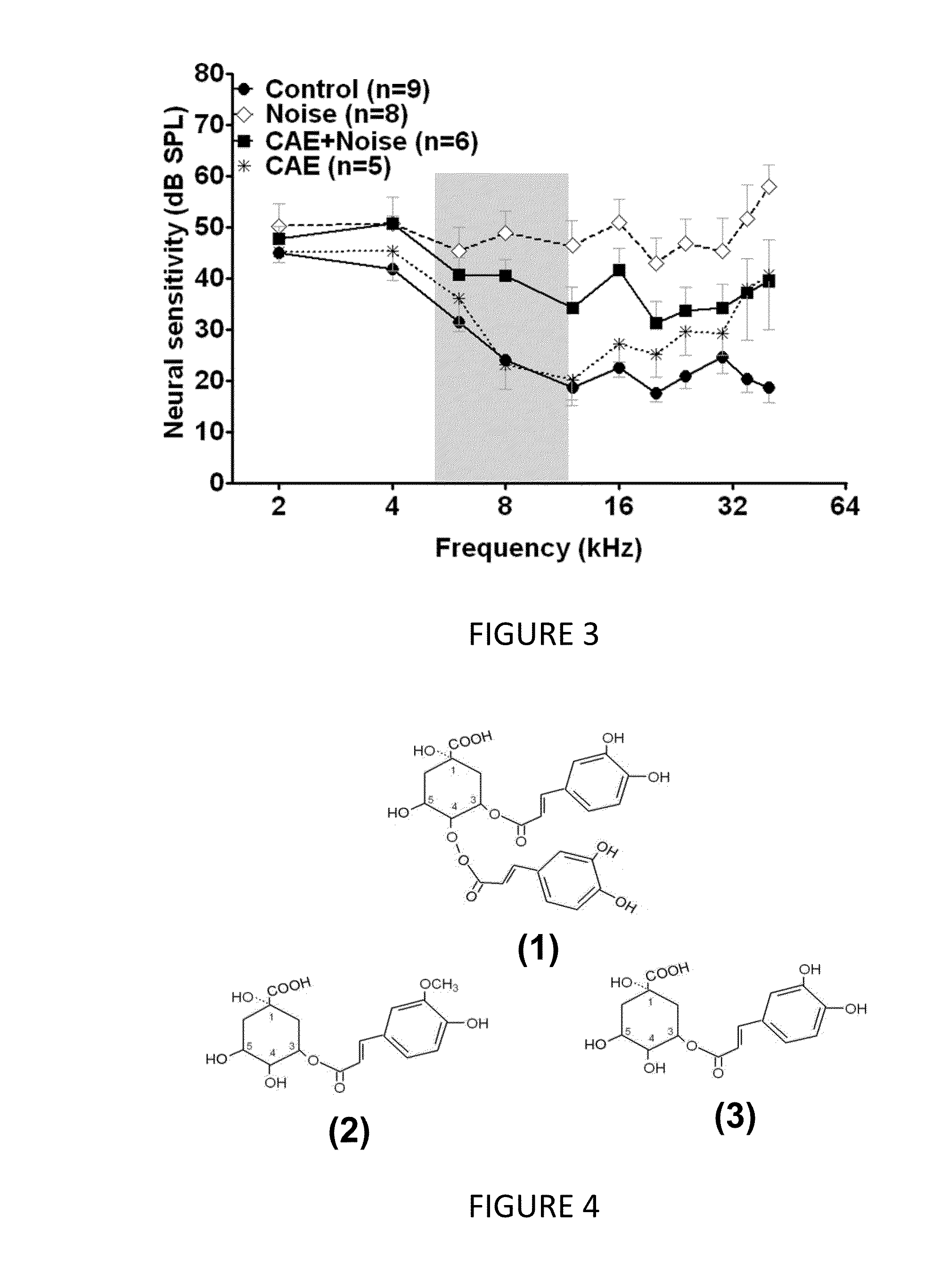Methods and compositions for preventing and treating auditory dysfunctions
a technology of auditory dysfunction and composition, applied in the field of auditory dysfunction, can solve the problems of high intensity noise, ongoing problem of auditory dysfunction in people, and increased risk of hearing loss,
- Summary
- Abstract
- Description
- Claims
- Application Information
AI Technical Summary
Benefits of technology
Problems solved by technology
Method used
Image
Examples
example 1
REFERENCES FOR EXAMPLE 1
[0175]Akesson, C., Lindgren, H., Pero, R. W., Leanderson, T., Ivars, F., 2003a. An extract of Uncaria tomentosa inhibiting cell division and NF-kappa B activity without inducing cell death. Int. Immunopharmacol. 3, 1889-900.[0176]Akesson, C., Lindgren, H., Pero, R. W., Leanderson, T., Ivars, F., 2005. Quinic acid is a biologically active component of the Uncaria tomentosa extract C-Med 100. Int Immunopharmacol. 5, 219-229.[0177]Akesson, C., Pero, R. W., Ivars, F., 2003b. C-Med 100, a hot water extract of Uncaria tomentosa, prolongs lymphocyte survival in vivo. Phytomedicine. 10, 23-33.[0178]Bacher, N., Tiefenthaler, M., Sturm, S., Stuppner, H., Ausserlechner, M. J., Kofler, R., Konwalinka, G., 2006. Oxindole alkaloids from Uncaria tomentosa induce apoptosis in proliferating, G0 / G1-arrested and bc1-2-expressing acute lymphoblastic leukaemia cells. Br J Haematol. 132, 615-622.[0179]Bartos, J., 1980. Colorimetric determination of organic compounds by formation o...
example 2
REFERENCES FOR EXAMPLE 2
[0271]1. Wood R D, Mitchell M, Lindahl T. Human DNA repair genes, 2005. Mutat Res. 2005;577:275-283.[0272]2. Fernandez-Capetillo O, Murga M. Why cells respond differently to DNA damage: a chromatin perspective. Cell Cycle. 2008;7:980-983.[0273]3. Köberle B, Roginskaya V, Wood R D. XPA protein as a limiting factor for nucleotide excision repair and UV sensitivity in human cells. DNA Repair 2006;5:641-648.[0274]4. Köberle B, Roginskaya V, Zima K S, Masters J R, Wood R D. Elevation of XPA protein level in testis tumor cells without increasing resistance to cisplatin or UV radiation. Mol Carcinog. 2008;47:580-586.[0275]5. Kang T H, Reardon J T, Sancar A. Regulation of nucleotide excision repair activity by transcriptional and post-transcriptional control of the XPA protein. Nucleic Acids Res.[0276]6. Guthrie O W, Li-Korotky H S, Durrant J D, Balaban C (2008) Cisplatin induces cytoplasmic to nuclear translocation of nucleotide excision repair factors among spiral ...
example 3
REFERENCES FOR EXAMPLE 3
PUM
| Property | Measurement | Unit |
|---|---|---|
| frequency | aaaaa | aaaaa |
| distance | aaaaa | aaaaa |
| molecular weight | aaaaa | aaaaa |
Abstract
Description
Claims
Application Information
 Login to View More
Login to View More - R&D
- Intellectual Property
- Life Sciences
- Materials
- Tech Scout
- Unparalleled Data Quality
- Higher Quality Content
- 60% Fewer Hallucinations
Browse by: Latest US Patents, China's latest patents, Technical Efficacy Thesaurus, Application Domain, Technology Topic, Popular Technical Reports.
© 2025 PatSnap. All rights reserved.Legal|Privacy policy|Modern Slavery Act Transparency Statement|Sitemap|About US| Contact US: help@patsnap.com



